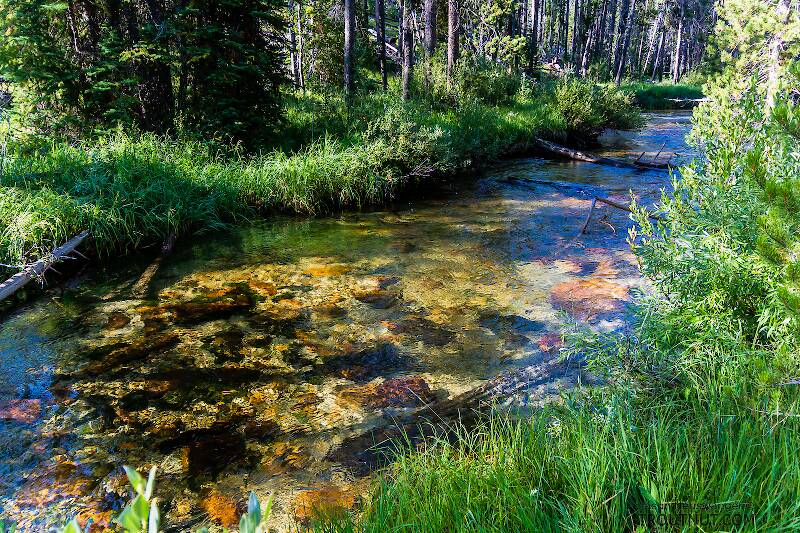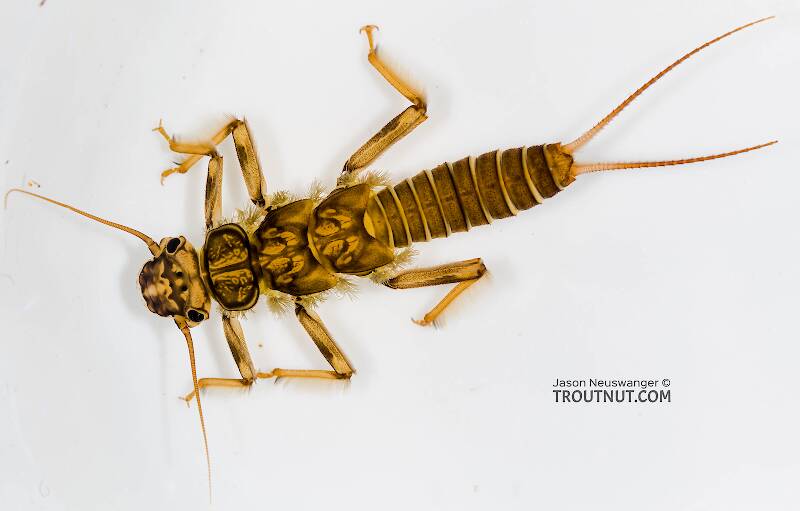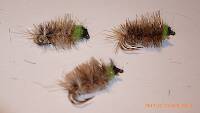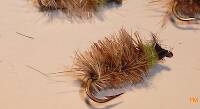
Salmonflies
Pteronarcys californica
The giant Salmonflies of the Western mountains are legendary for their proclivity to elicit consistent dry-fly action and ferocious strikes.
Featured on the forum

Troutnut is a project started in 2003 by salmonid ecologist Jason "Troutnut" Neuswanger to help anglers and
fly tyers unabashedly embrace the entomological side of the sport. Learn more about Troutnut or
support the project for an enhanced experience here.
Rio on Feb 24, 2007February 24th, 2007, 6:58 am EST
Hello, I fish in Michigan. I was wondering whether someone has a particularly good scud pattern?
Redband on Feb 24, 2007February 24th, 2007, 5:44 pm EST
I like a pattern that is tied with beads, Tying Glass Bead flies, (Joe Warren) has a good pattern, it glows in the water from the beads.
Every Day of work is one day closer to retirement.
Rio on Feb 25, 2007February 25th, 2007, 7:52 am EST
Thanks, I did not think of beads. I wonder if I can find a picture of his fly on the net?
Brntrout on Feb 25, 2007February 25th, 2007, 10:13 am EST
Here is a simple pattern that has caught thousands of trout for me! I've fished this pattern for thirty years with only a couple of material changes made to this pattern.
Hook: TMC 2487, 2457 or equivalent
Thread: use color to match the dubbing/body color.
Ribbing: mono, gold wire or copper wire
Overshell: Electra Braid ( material made by Gudebrod)use the pearl hologram color.
Body: I use a 50/50 blend of natural fur and Ice Dubbing mixed. The body colors I use are: gray olive, orange, olive, off white or gray.
1. Put hook in vise, wrap in thread.
2. Wrap thread back to the bend of the hook and tie in the ribbing and the Electra Braid. Leave both the electra braid and ribbing hanging off the back end of the hook bend.
4.Apply dubbing mixture to thread and wrap forward toward hook eye. The dubbed body should be slimmer toward the bend of the hook and more robust toward the eye of the hook but should taper down slightly before reaching the eye of the hook.
5.Once the dubbing is secured just behind the hook eye, pull the electra braid over the top or back of the fly and tie it off.
6. Next wrap the ribbing around the body/electra braid about five or six turns. Tie off the materials and form a nice thread head.
7. Lastly, pick the dubbing out a lttle bit on the belly side of the fly too achieve a nice buggy look and the fly is completed!
Hook: TMC 2487, 2457 or equivalent
Thread: use color to match the dubbing/body color.
Ribbing: mono, gold wire or copper wire
Overshell: Electra Braid ( material made by Gudebrod)use the pearl hologram color.
Body: I use a 50/50 blend of natural fur and Ice Dubbing mixed. The body colors I use are: gray olive, orange, olive, off white or gray.
1. Put hook in vise, wrap in thread.
2. Wrap thread back to the bend of the hook and tie in the ribbing and the Electra Braid. Leave both the electra braid and ribbing hanging off the back end of the hook bend.
4.Apply dubbing mixture to thread and wrap forward toward hook eye. The dubbed body should be slimmer toward the bend of the hook and more robust toward the eye of the hook but should taper down slightly before reaching the eye of the hook.
5.Once the dubbing is secured just behind the hook eye, pull the electra braid over the top or back of the fly and tie it off.
6. Next wrap the ribbing around the body/electra braid about five or six turns. Tie off the materials and form a nice thread head.
7. Lastly, pick the dubbing out a lttle bit on the belly side of the fly too achieve a nice buggy look and the fly is completed!
brntrout
Brett on Feb 26, 2007February 26th, 2007, 4:53 am EST
A major part of fishing a true scud imitation is presentation. Scuds are also called "sideswimmers" and move about near the bottom in jerky movements, usually on their side. I know that fishing them under a strike indicator so that they are near bottom is a good way to present them. If the surface of the water has a slight chop, to impart a jerky action below, so much the better. However, I wonder if anyone has addressed the "side" swimming profile of scuds in a pattern / manner of presentation. We can certainly tie "clouser style" flies with weight on the top of the hook to make it ride upside-down. Has anyone thought about how to make a scud pattern that actually presents itself in a sideways manner? I wonder if weighting the hook on one side and adding buoyant materials (CDC, polypropolene, beaver belly)on the other side would work? Maybe bending the hook shank slightly sideways to the left or right would help? Would love to hear the ideas from folks on this one... By the way, Fox Statler, a White River, Arkansas guide, has some very good scuds that do well on his big tailwaters. A major factor that he credits for their effectiveness is the length and motion of the flies' legs. He achieves this by cutting and remixing the dubbing several times till he can "touch dub" the prickly dubbing to the tying thread and achieve appropriate leg length.
Brett
Novice entomologist, fly-tyer and photographer
Novice entomologist, fly-tyer and photographer
Troutnut on Feb 26, 2007February 26th, 2007, 6:17 pm EST
Scuds are also called "sideswimmers" and move about near the bottom in jerky movements, usually on their side.
I'm not sure I would describe their motion as jerky. They seem have one of the smoothest swimming motions of any aquatic invertebrates. Most mayflies swim with awkward wiggles or short, fast bursts, but the scuds I've watched in the wild just seem to leisurely glide around the bottom. That pretty much goes for the ones I watch in my sampling trays, too, except it's not so leisurely when I'm chasing them with tweezers.
Jason Neuswanger, Ph.D.
Troutnut and salmonid ecologist
Troutnut and salmonid ecologist
Brett on Feb 27, 2007February 27th, 2007, 7:27 am EST
Jason,
Thanks for your insight. Now that you mention it, most scuds I've watched were in sampling buckets, vials or other such artificial environs. That would account for jerky motion. Glad you're spending some time observing underwater behavior. Most insightful!
Brett
Thanks for your insight. Now that you mention it, most scuds I've watched were in sampling buckets, vials or other such artificial environs. That would account for jerky motion. Glad you're spending some time observing underwater behavior. Most insightful!
Brett
Brett
Novice entomologist, fly-tyer and photographer
Novice entomologist, fly-tyer and photographer
Rio on Feb 28, 2007February 28th, 2007, 9:56 am EST
I had success with impressionistic scud patterns. Then, I fished the White River in Ark with a well known guide. We had great success despite very bad weather, huge coldfront and plunging of the barometer.
Abnormally cold. Yet, we my wife and I released 49 good trout. His scud pattern was so lifelike that I thought it would crawl off the palm of my hand. It was smokey gray with eyes, antennae and perhaps a shellback made from mono? I reminded me of what I think a freshwater shrimp would look like. Those were his special flies and I did not press him for details of the construction but I never saw anything like them before or since.
Abnormally cold. Yet, we my wife and I released 49 good trout. His scud pattern was so lifelike that I thought it would crawl off the palm of my hand. It was smokey gray with eyes, antennae and perhaps a shellback made from mono? I reminded me of what I think a freshwater shrimp would look like. Those were his special flies and I did not press him for details of the construction but I never saw anything like them before or since.
GONZO on Mar 3, 2007March 3rd, 2007, 9:10 am EST
Hi Rio,
A while back I posted one of my favorite scud patterns under the "Favorite flies" thread on the fly-tying board. You might want to check it out. By the way, the ever-resourceful Louis (Martinlf) has discovered a source for the 2mm (1/16") Swannundaze required.
Brett, while scuds are often called "sideswimmers," in my observations they seem quite content to swim in any orientation--upright, upside-down, or on their sides. Jason is right about their fluid swimming motions, although their direction changes and changes of orientation as they scavenge around could be called "erratic."
The original reason for my use of the old and unusual Mustad 37160 in the scud pattern mentioned above was to create a fly that was intentionally unstable. Unlike many of my other efforts to create balanced flies with strong orientation, I wanted to capture the scud's distinctive movements (with or without motion added by the angler).
A while back I posted one of my favorite scud patterns under the "Favorite flies" thread on the fly-tying board. You might want to check it out. By the way, the ever-resourceful Louis (Martinlf) has discovered a source for the 2mm (1/16") Swannundaze required.
I wonder if anyone has addressed the "side" swimming profile of scuds in a pattern/manner of presentation
Brett, while scuds are often called "sideswimmers," in my observations they seem quite content to swim in any orientation--upright, upside-down, or on their sides. Jason is right about their fluid swimming motions, although their direction changes and changes of orientation as they scavenge around could be called "erratic."
The original reason for my use of the old and unusual Mustad 37160 in the scud pattern mentioned above was to create a fly that was intentionally unstable. Unlike many of my other efforts to create balanced flies with strong orientation, I wanted to capture the scud's distinctive movements (with or without motion added by the angler).
Taxon on Mar 3, 2007March 3rd, 2007, 9:57 am EST
Gonzo-
Not familiar with Mustad 37160's. What characteristic of that hook makes it inherently unstable?
Not familiar with Mustad 37160's. What characteristic of that hook makes it inherently unstable?
GONZO on Mar 3, 2007March 3rd, 2007, 1:13 pm EST
Roger,
The 37160 is an old Mustad style with a radically curved shank (even by today's standards), a sharp Limerick style bend, an upturned eye, and is reversed (offset). These features (especially the offset, which commences at mid-shank) make it unstable. It is sometimes called an English bait hook, and the Kahle is a similar hook with a straight eye. If I'm remembering correctly, it was Gary Borger who pointed out how simple worm flies were enhanced by its action in the water.
The 37160 is an old Mustad style with a radically curved shank (even by today's standards), a sharp Limerick style bend, an upturned eye, and is reversed (offset). These features (especially the offset, which commences at mid-shank) make it unstable. It is sometimes called an English bait hook, and the Kahle is a similar hook with a straight eye. If I'm remembering correctly, it was Gary Borger who pointed out how simple worm flies were enhanced by its action in the water.
Rio on Mar 6, 2007March 6th, 2007, 10:23 am EST
Gonzo, I purchased your book because I saw it recommended here. I am extremely impressed. I hope that you do a second book covering flies like scuds, terrestrials etc. I found your scud pattern. I am going to try to replicate that pattern now. Later, I will order the needed hook. I am sure that your hook choice contributes to the proper movement. I cant wait to try your Brown Drake patterns in front of my lodge. My vacation home is right on a trophy section of a trout river and I get outstanding Brown Drake and White fly hatches.
Although, I do have concern about the duns floating without hackle. Thanks to Jason and you and others posting here, for this excellent and informative site. I have learned so much.
Although, I do have concern about the duns floating without hackle. Thanks to Jason and you and others posting here, for this excellent and informative site. I have learned so much.
Martinlf on Mar 6, 2007March 6th, 2007, 12:48 pm EST
"He spread them a yard and a half. 'And every one that got away is this big.'"
--Fred Chappell
--Fred Chappell
VERNO on Mar 9, 2007March 9th, 2007, 2:05 am EST
Hey Now....this is my 1st time posting here...I've been lurking for a little while....thought I might share some info on scuds (one of my favorite flies to tie).....My question would be what size scuds are you encountering?
here's a link to some Scanning Electron Microscope images.....there is one called pond shrimp worth looking at....my personal favorite scud for pressured waters is a size 18 hook osterich herl rib, and just a light grey dubbing....after dubbing a body simply wrap the osterich and tie off....next carefully trim the top of the herl fibers and dab the top of the scud with flexament of soft tex..unbeliveably easy to tie, but very effective....I use this pattern all the time on a heavily fished spring creek in Upstate, NY.....I also have another more traditional pattern in 12 0r 14 if interested.
Great site here, and I hope to contribute more in the future
here's a link to some Scanning Electron Microscope images.....there is one called pond shrimp worth looking at....my personal favorite scud for pressured waters is a size 18 hook osterich herl rib, and just a light grey dubbing....after dubbing a body simply wrap the osterich and tie off....next carefully trim the top of the herl fibers and dab the top of the scud with flexament of soft tex..unbeliveably easy to tie, but very effective....I use this pattern all the time on a heavily fished spring creek in Upstate, NY.....I also have another more traditional pattern in 12 0r 14 if interested.
Great site here, and I hope to contribute more in the future
Mama said; Don't Go Near That River........
Selling My Craft: http://www.jsflyfishing.com/cgi-bin/category/31240
Selling My Craft: http://www.jsflyfishing.com/cgi-bin/category/31240
VERNO on Mar 9, 2007March 9th, 2007, 2:06 am EST
Mama said; Don't Go Near That River........
Selling My Craft: http://www.jsflyfishing.com/cgi-bin/category/31240
Selling My Craft: http://www.jsflyfishing.com/cgi-bin/category/31240
Troutnut on Mar 9, 2007March 9th, 2007, 3:08 am EST
Cool electron microscope pics!
Anybody want to donate $10,000 to start up a "Get Troutnut.com A Scanning Electron Microscope" fund? Anyone?
I need to make some really rich friends...
Anybody want to donate $10,000 to start up a "Get Troutnut.com A Scanning Electron Microscope" fund? Anyone?
I need to make some really rich friends...
Jason Neuswanger, Ph.D.
Troutnut and salmonid ecologist
Troutnut and salmonid ecologist
VERNO on Mar 9, 2007March 9th, 2007, 5:23 am EST
Jason....I guess it's one of the few benefits from work....but if you really want to see a particular bug under the electron let me know.
Mama said; Don't Go Near That River........
Selling My Craft: http://www.jsflyfishing.com/cgi-bin/category/31240
Selling My Craft: http://www.jsflyfishing.com/cgi-bin/category/31240
Pittendrigh
Posts: 1
Posts: 1
Pittendrigh on May 14, 2007May 14th, 2007, 5:15 pm EDT
/* Colin (Sandy) Pittendrigh >--oO0>
** http://montana-riverboats.com
*/
** http://montana-riverboats.com
*/
Quick Reply
Related Discussions
Topic
Replies
Last Reply
6
Sep 11, 2020
by Martinlf
by Martinlf
0
Jan 27, 2017
by Mcflyangler
by Mcflyangler







